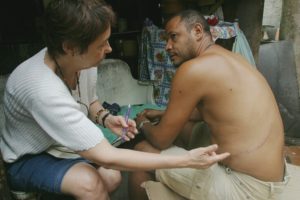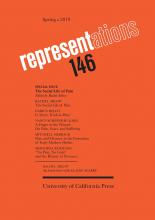A Finger in the Wound: On Pain, Scars, and Suffering
by Nancy Scheper-Hughes


from the section “The Embodiment of Pain”:
Margaret Lock’s and my 1987 essay, “The Mindful Body: A Prolegomenon to Future Work in Medical Anthropology,” emerged out of our profound dissatisfaction with the limitations of our discipline and field of inquiry. What good, after all, was a medical anthropology that was simply a convenient application of anthropological ideas and methods to clinical models of illness, pain, suffering, and healing? We wanted our field to be transformative, both theoretically and in terms of praxis. So we began to sketch a framework suggesting what medical anthropology could do beyond an empathic handholding of doctors and patients. We questioned the body as a cultural, historical, medicalized, naturalized, and universal object. We introduced the notion of embodiment, or how people, individually and collectively, live in and experience the body-self. We devised a tripartite framework of the “three bodies”: the individual body/the body self; the social body; and the political body or the body politic. The three bodies represent, then, three different but overlapping levels of analysis and theory: the existential/phenomenological/ontological individual body; the social structural/symbolic (the social body); and the feminist/neo-Marxist, Foucauldian body as a site of power/knowledge (the political body).
The individual body is a given, biopsychological, existential reality. It refers to the processes of becoming and being a person, an embodied self. In this instance, the body is seen as unique, singular, individual, and personally experienced. At the same time, this “individual” body—conceived as the center of the perceiving, experiencing, thinking world—is always mediated through collective cultural meanings. The self-evident yet contradictory proposition is that humans both have and are bodies. Our bodies are simultaneously objects of and subject to our “selves.” We could say that we are at one and the same time insiders and outsiders to ourselves. The message of the American wellness movement at the time we were writing was rather crude: “It’s your body. Take care of it.” The concept of the body as property means that you own it and you have the responsibility to take care of it. But on a deeper level, the body is proof of one’s existence. It is through the body and its sensory and perceptual circuits that we are able to experience and differentiate among other objects and things in the world. The body, wrote Marcel Mauss, is the “first and most natural tool” of humans. But here’s the rub: how can one simultaneously be it and own it?
In his classic work The Phenomenology of Perception, Maurice Merleau-Ponty argued that although humans are not unique in being embodied, they might be the only species that is en-selved, endowed with self-consciousness, self-awareness, and self-reflection. While primates and other animals grieve the death of their loved ones, only humans are painfully conscious of the limits of their being-in-the-world. Ludwig Binswanger, drawing on Edmund Husserl and Martin Heidegger, writes of “thrownness”: the idea that individual bodies are “thrown” into a particular world, place, history, and existence without their choosing. Our genetic inheritance, generation, environment, and society; our family, race, culture, and history are thrown at us, as the raw materials out of which to create a life.
On the one hand, then, our bodies are the “tools” with which we perceive, think, and act in and on the world; on the other, bodies can seem to betray us, to defeat us. In extreme situations, our bodies can even seem to be obstacles to our freedom. Bodies can frustrate our basic needs and deepest desires. The suffering of transgender people is just one example of a body betrayed. One might, like Albie Sachs, an anti-apartheid hero, lose a limb in a political attack on one’s life. Albie’s suffering during a long recovery eventually shaped him into a more open and compassionate human and an even better ANC (African National Congress) warrior. Albie was proud of his missing limb and refused to wear a prosthesis. He would wave his empty sleeve as if it were his flag of liberty, which I thought it was. Or, like Diane DeVries, one could be born without any limbs at all and refuse the sometimes very painful attempts to navigate on the remaining stumps. The pain was worth her self-perception as a unique beauty, an American Venus de Milo. Continue reading …
Pain is a deeply subjective experience that includes sensory, emotional, social, historical, and cultural components. The presence of suffering in the idiom of pain exposes the gap between individual bodies that refuse to suffer quietly and the violence of indifferent social, economic, and political orders. In this essay Nancy Scheper-Hughes describes the existential suffering of Brazilian sugarcane cutters who transform the unbearable shame of hunger into a more acceptable bodily syndrome of nervous rage. Who, after all, wants to suffer and die like a dog? Her second example of the precariousness of pain is the muted suffering and longing of impoverished kidney sellers in Moldova who suffer a missing kidney that they experience as an angry and ghostly organ that will not allow the sellers to forget what they have done to themselves.
NANCY SCHEPER-HUGHES is Chancellor’s Professor of Anthropology and Professor of the Graduate School at UC Berkeley. She is the author of many books, including Saints, Scholars and Schizophrenics: Mental Illness in Ireland (1979, 2001), and Death Without Weeping: The Violence of Everyday Life in Brazil (1993). As founding director of Organs Watch, she is a consultant on human trafficking of organs for the EU, Interpol, the UN Office on Human Trafficking, and the Vatican. Her forthcoming books are The Ghosts of Colonia Montes de Oca: A Hidden Subtext of Argentina’s Dirty War and Kidney Hunter: Trafficking with the Organs Traffickers.

 “The essays collected here counter [the] fantasy of pain as a knowable sensation that lies within that is then represented, or misrepresented, in language. Instead, they consider pain as always already enmeshed in social life, and representation as the means through which we can engage this imbrication. In so doing, they demonstrate the importance of bringing together two approaches to the problem of pain that have often been kept distinct. The first is the anthropological insight that pain behavior constitutes a mode of social engagement and, hence, that suffering is necessarily bound up with shifting, often unpredictable, cultural, familial, and interpersonal dynamics. The second involves a historical and literary-critical account of representation’s complex and productive relations to both experience and culture.” –from the editor’s introduction
“The essays collected here counter [the] fantasy of pain as a knowable sensation that lies within that is then represented, or misrepresented, in language. Instead, they consider pain as always already enmeshed in social life, and representation as the means through which we can engage this imbrication. In so doing, they demonstrate the importance of bringing together two approaches to the problem of pain that have often been kept distinct. The first is the anthropological insight that pain behavior constitutes a mode of social engagement and, hence, that suffering is necessarily bound up with shifting, often unpredictable, cultural, familial, and interpersonal dynamics. The second involves a historical and literary-critical account of representation’s complex and productive relations to both experience and culture.” –from the editor’s introduction